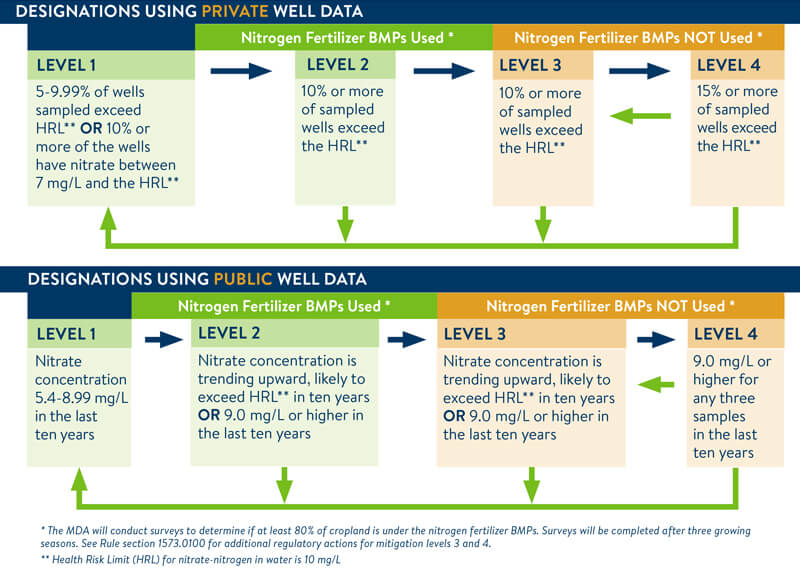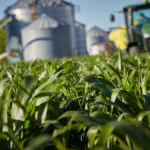
The Minnesota Department of Agriculture (MDA) has released the draft Nitrogen Fertilizer Rule, which is being implemented to minimize potential sources of nitrate pollution in the state’s groundwater and as part of the Minnesota Nitrogen Fertilizer Management Plan.
The comment period for the draft Nitrogen Fertilizer Rule ended August 25, 2017. In an effort to increase farmer input, MCGA sent a post card to more than 24,000 Minnesota corn farmers urging them to learn more about the rule and submit comments. In addition, MCGA President Harold Wolle authored an op-ed that ran in numerous Minnesota newspapers and participated in radio interviews asking farmers to comment on the rule.
- More than 800 comments were submitted to the Minnesota Department of Agriculture (MDA) prior to the Aug. 25, 2017 deadline. All public comments received by MDA can be viewed here.
- Minnesota Corn Growers Association (MCGA) farmer leaders submitted comments on behalf of the organization. You can read those comments here.
According to MDA, after they review and incorporate the comments that were submitted by Aug. 25, the official draft rule will be released in May. This will be followed by an additional comment period where the public will have another opportunity to provide feedback before the rule is finalized and released. MDA says they expect the final rule to go into effect by the end of the year. For the latest news on the draft rule, click here.
Here are some FAQs about the proposed rule:
Where did this rule come from?
The nitrogen fertilizer rule is based on the Minnesota Nitrogen Fertilizer Management Plan, which outlines the state’s strategy for preventing contamination and responding to elevated nitrate from fertilizer in groundwater. This plan first originated in 1990 followed by a three-year revision before being released in March 2015. The nitrogen fertilizer rule outlines the MDA’s procedure to regulate nitrogen fertilizer use in vulnerable groundwater areas and areas of high concentration.
When will the law go into effect?
Expected by the end of the year.
How are nitrate levels determined?
The MDA uses nitrate data from both public and private drinking wells to evaluate pollution frequency and concentration trends.
How do I know if I am in a vulnerable groundwater area and restricted from fall nitrogen application?
A vulnerable groundwater area is land where nitrate can move easily through the soil into groundwater. The saturated hydraulic conductivity of the soil, which measure the soil’s ability to transmit water, as well as if there is karst or bedrock at or near the surface determines if the area is vulnerable. MCGA recommends you view the current vulnerable groundwater area map to see if you are affected.
Vulnerable groundwater areas will be determined section by section. In areas where more than 50% of the section has vulnerable groundwater, fall and frozen soil application will not be allowed in the entire section. If less than half of the section has vulnerable groundwater, application is only restricted to fields with karst or near-surface bedrock. Key exceptions include the application of phosphorous fertilizers (Monoammonium Phosphate and Diammonium Phosphate) and other micronutrients that contain nitrogen. The overall applied nitrogen rate must not exceed 20 pounds per acre.
If my farm is located in an area of high nitrate concentration in groundwater, what is the mitigation process?
Mitigation, or the action to reduce severity, is separated into four levels depending on the level of nitrate concentration found in private and public drinking wells. All areas identified with nitrate contaminated ground water will begin in a voluntary level of mitigation level 1 or 2, depending on if it is near or over the nitrate health risk limit of 10 milligrams per liter. Nitrogen fertilizer BMPs and alternative practices will be promoted within these areas under the advisement of a local advisory team.
The MDA will reevaluate the mitigation level after three growing seasons. Land owners may find themselves in level 3 and 4 if nitrogen fertilizer BMPs are not being used and nitrate groundwater levels exceed the health risk limit. Areas in these regulatory levels will be subject to specific management practices ordered by MDA.

MN Department of Agriculture mitigation criteria map
What are the consequences of not following the nitrogen fertilizer rule?
The general progression of non-compliance includes: 1) educating the landowner, 2) compliance assistance and 3) enforcement. For the latter, the MDA has authority to issue administrative, civil and criminal penalties.
How has MCGA been involved?
MCGA has been involved throughout the nitrogen fertilizer rule’s revision process, including:
- Submission of comments on the overall Nitrogen Fertilizer Management Plan in 2013
- Submission of comments on the initial proposed Nitrogen Fertilizer Rule in 2016
- MCGA representation on the Nitrogen Fertilizer Management Plan advisory committee to provide input on the various aspects of the management plan
- MCGA farmer leaders submitted comments on the draft Nitrogen Fertilizer Rule on behalf of MCGA. Click here to read those comments.
- In an effort to increase farmer input, MCGA sent a post card to more than 24,000 Minnesota corn farmers urging them to learn more about the rule and submit comments.
- MCGA President Harold Wolle also authored an op-ed that ran in numerous Minnesota newspapers and participated in radio interviews asking farmers to comment on the rule.
 The Minnesota Corn Growers Association (MCGA) and Minnesota Corn Research & Promotion Council (MCR&PC) are committed to funding independent research that seeks to enhance opportunities for Minnesota corn farmers by improving agricultural practices and creating new markets for what they produce.
The Minnesota Corn Growers Association (MCGA) and Minnesota Corn Research & Promotion Council (MCR&PC) are committed to funding independent research that seeks to enhance opportunities for Minnesota corn farmers by improving agricultural practices and creating new markets for what they produce.
Minnesota corn checkoff dollars fund a wide range of research projects, including the development of value-added products, the management of corn inputs, issues related to ethanol use, the evaluation of genetic traits, and the relationship between agricultural management practices and water quality.
For more information on research projects funded by Minnesota’s corn farmers click here.

